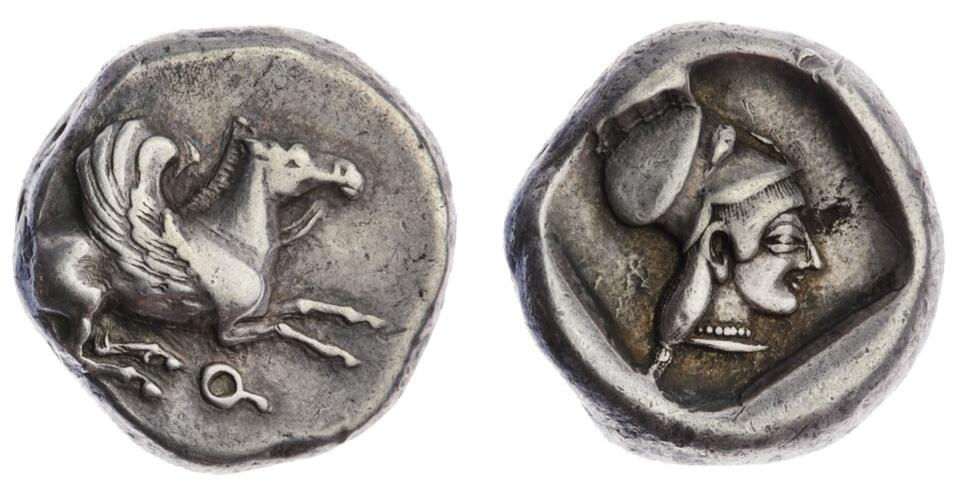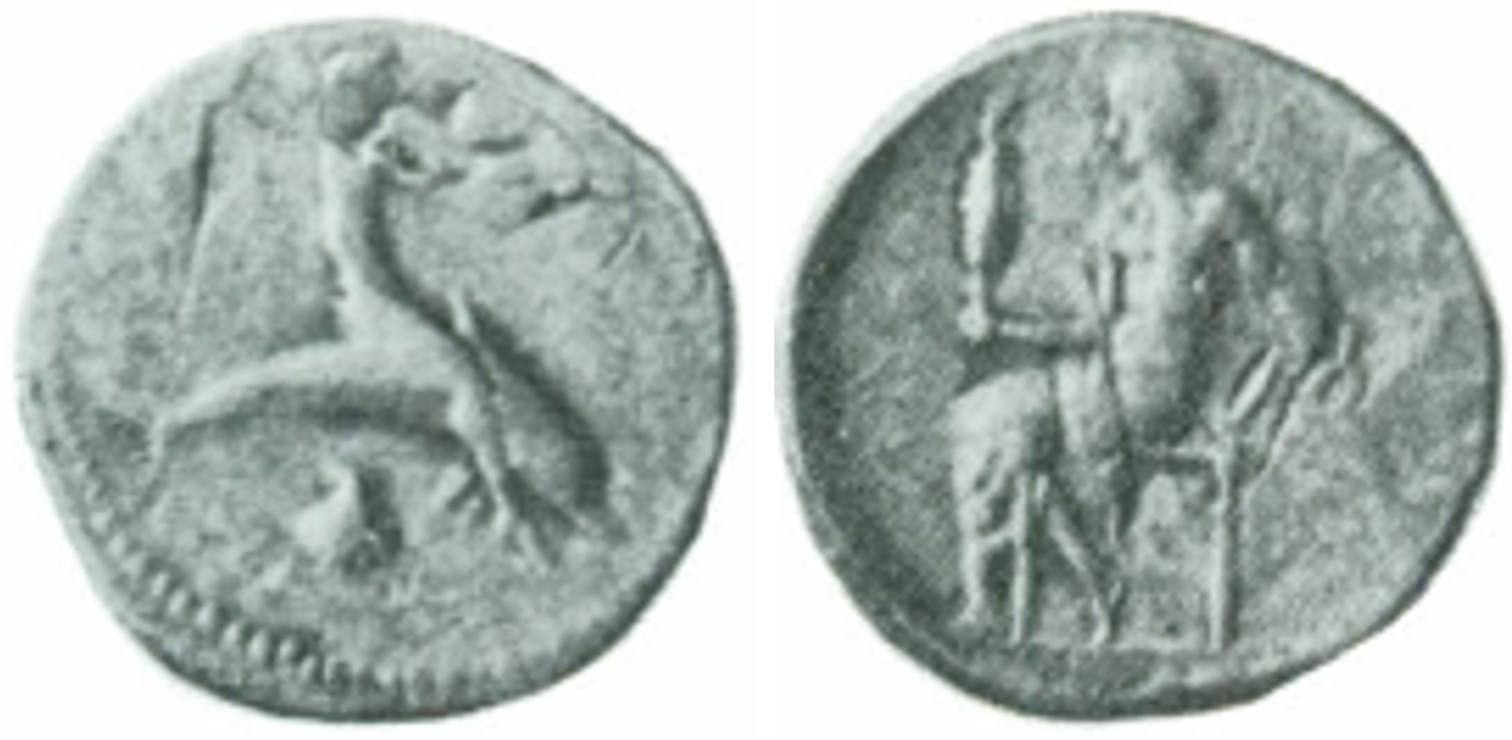2005 - Taras (nomos Taras/seated oikist) over Corinth (Pegasus/Athena) (Florence, MA)
From SILVER
450 BCE - 440 BCE
Images
Overstruck variety

Corinth Archaic Pegasus Athena right.jpeg [1]
Location/history
| Museum collectionMuseum collection: | Florence, Museo Archeologico Nazionale | |
Overstriking coin
Description
| ObverseInscription or printing placed on the obverse.: | Male character (Taras or Phalanthos), nude, seated on dolphin to right. Below, shell. Border of dots. | ReverseInscription or printing placed on the reverse.: | Oecist seated left, drapery on legs, holding distaff with right hand and his seat with left hand. |
Mint and issuing power
| MintIdentifies the place of manufacture or issue of a numismatic object.: | Taras | Ancient regionAncient region. | Calabria | Modern countryModern country: Italy | AuthorityIdentifies the issuing power. The authority can be "pretended" when the name or the portrait of X is on the coin but he/she was not the issuing power. It can also be "uncertain" when there is no mention of X on the coin but he/she was the issuing power according to the historical sources: |
Chronology
| FromIdentifies the initial date in a range assigned in a numismatic context. 450 BCE toIdentifies the final date in a range assigned in a numismatic context.. 440 BCE | Classical 480-323 BC |
Physical description
| MetalThe physical material (usually metal) from which an object is made.: Silver |
DenominationTerm indicating the value of a numismatic object. Examples: tetradrachm, chalkous, denarius.: nomos | ||
| StandardStandard.: Achaian | |||
References
| Coin referenceReference of the Coin: | Garraffo 1989, p. 59, 1a et pl. 71, n° 1 | Coin series referenceReference to coin series study: | Garraffo 19891Garraffo 1989, p. 59, 1a et pl. 71, n° 1, Fischer-Bossert 19992Fischer-Bossert 1999, n° 251, HN Italy3HN Italy, n° 843-846, HGC 14HGC 1, n° 757-759 |
| Coin series web referenceCoin series web references: | |||
Overstruck type
Description
| ObverseInscription or printing placed on the obverse.: | Pegasus flying right (visible on reverse: inferior part). | ReverseInscription or printing placed on the reverse.: | Head of Athena right, wearing a Corinthian helmet (visible on obverse: inferior part of the head). |
Mint and issuing power
| MintIdentifies the place of manufacture or issue of a numismatic object. ᵖ: | Corinth | Ancient regionAncient region. ᵖ | Peloponnesus | Modern countryModern country: Greece | AuthorityIdentifies the authority in whose name (explicitly or implicitly) a numismatic object was issued. ᵖ: |
Chronology
| FromIdentifies the initial date in a range assigned in a numismatic context. 510 BCE toIdentifies the final date in a range assigned in a numismatic context.. 450 BCE | Archaic until 480 BC |
Physical description
| DenominationTerm indicating the value of a numismatic object. Examples: tetradrachm, chalkous, denarius. ᵖ: | stater |
References
| Coin type referenceReference to coin series study ᵖ: | Ravel 19365Ravel 1936, n° 252, Calciati 19906Calciati 1990 | ||
| Coin series web reference overstruckCoin series web references overstruck: | |||
Additional data
| Frequency of overstrikesFrequency of overstrikes: | rare and concentrated | Level of confidenceLevel of confidence of the identification: | sure |
| RemarksRemarks: | |||
References
- ^ Garraffo, Salvatore (1989), "Riconiazioni e cronologie in Magna Grecia", in G. Le Rider et al. (éd.), Kraay-Morkholm essays, Louvain-la-Neuve, p. 59-67, pl. 71.
- ^ Fischer-Bossert, Wolfgang (1999), Chronologie der Didrachmenprägung von Tarent, 510-280 v. Chr., Berlin, De Gruyter, xvii, 495 p., [84] pl.
- ^ Rutter N. Keith et alii (eds.) (2001), Historia Numorum Italy, London, xvi, 223 p., 43 pl.
- ^ Hoover, Oliver D. (2018), The Handbook of Greek Coinage Series, Volume 1. Handbook of Coins of Italy and Magna Graecia, Sixth to First Centuries BC., Lancaster-London, 2018, lxi, 527 pages, 23 cm
- ^ Ravel, Oscar E (1936), Les "Poulains" de Corinthe : monographie des statères corinthiens. Tome I: de 650 à 415 J.-C., Basel.
- ^ Calciati, Romolo (1990), Pegasi, Mortara, Edizioni I.P..
